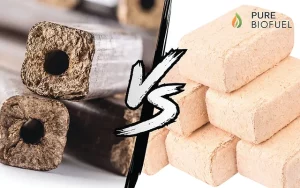RUF Briquettes VS Pini Kay Briquettes
RUF briquettes and Pini kay briquettes are two of the most popular types of wood briquettes used for heating purposes. While they may seem similar, they differ in several ways, including composition, shape, density, and burning characteristics.

Composition:
RUF briquettes are made from sawdust and wood shavings that are compressed without the use of binding agents. In contrast, Pini kay briquettes are made from hardwood sawdust and require a small amount of binding agents. The use of binding agents in Pini kay briquettes is to provide structural integrity and help the briquette hold its shape.
Shape:
The shape of the briquette is another major difference between RUF briquettes and Pini kay briquettes. RUF briquettes have a rectangular shape with rounded edges, while Pini kay briquettes have a unique shape with a hole in the center. The hole in the center of the Pini kay briquette serves as an air vent, which allows for a more efficient and complete combustion process.
Density:
RUF briquettes are denser than Pini kay briquettes due to the lack of binding agents. The high-density of RUF briquettes allows them to burn hotter and longer than Pini kay briquettes. However, Pini kay briquettes are also denser than regular firewood and provide a more efficient heat output.
Burning Characteristics:
Both RUF briquettes and Pini kay briquettes have similar burning characteristics, producing a high heat output with low ash content. However, due to the higher density of RUF briquettes, they tend to burn longer and hotter than Pini kay briquettes. In contrast, Pini kay briquettes burn more efficiently due to the air vent in the center of the briquette.
Environmental Impact:
Both RUF briquettes and Pini kay briquettes are environmentally friendly and sustainable sources of fuel. They are made from compressed wood waste, which would otherwise be disposed of in landfills or burned in incinerators. The use of wood briquettes as a heating source helps to reduce the dependence on fossil fuels and reduces the carbon footprint of heating homes and businesses.
Availability and Cost:
The availability and cost of RUF briquettes and Pini kay briquettes vary depending on location. RUF briquettes are more widely available in the market and can be found in many home improvement stores and online retailers. Pini kay briquettes, on the other hand, are less common and may be harder to find. Additionally, the cost of each type of briquette can vary depending on location, availability, and demand.
Which Briquette Should You Choose? Choosing between RUF briquettes and Pini kay briquettes depends on personal preference, availability, and intended use. If you are looking for a dense, long-lasting heat source, RUF briquettes may be the better choice. However, if you are looking for a more efficient and complete combustion process, Pini kay briquettes may be the better option.
In terms of availability and cost, RUF briquettes are more widely available and may be more affordable in some regions. Pini kay briquettes, while less common, may be more readily available in regions with a significant supply of hardwood sawdust.
Are RUF briquettes any good?
RUF briquettes is great for general burning and starting the fire. Handy size so they are excellent on a smaller stove or open fire, but still big enough for large stoves. Excellent quality, oak sawdust briquettes. A minimum of three briquettes should be loaded at any given time.
Which wood briquettes are best?
The most popular type of wood briquettes are sawdust briquettes. With a moderate heat output, low price, and long burn time, they are a great general-use option that will suit most occasions. Heat logs. Heat logs are made from highly compressed, ultra-low-moisture sawdust.
Conclusion:
RUF briquettes and Pini kay briquettes are both excellent sources of sustainable and environmentally friendly heating fuel. They differ in composition, shape, density, and burning characteristics, and choosing between the two comes down to personal preference and intended use. Regardless of which type of briquette you choose, both offer a more efficient and eco-friendly heating option compared to traditional firewood.